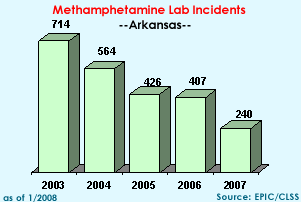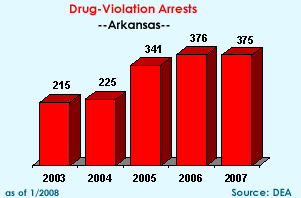|
DEA
Offices & Telephone Nos.
Fayetteville—501-442-2618
Fort Smith—501-783-6300
Little Rock—501-312-8602 |
State Facts
Population: 2,779,154
State Prison Population: 13,807
Probation Population: 29,128
Violent Crime Rate
National Ranking: 15 |
2007
Federal Drug Seizures
Cocaine: 181.6 kgs.
Heroin: 0.0 kgs.
Methamphetamine: 17.9 kgs.
Marijuana: 3,788.5 kgs.
Hashish: 0.0 kgs
MDMA: 0.0 kgs/51 du
Meth
Lab Incidents: 240
(DEA, state, and local) |
Drug
Situation: The availability and rate of drug abuse in Arkansas remain high coinciding with the smuggling of methamphetamine, cocaine, and marijuana, the drugs of choice, for local consumption and further distribution. Though smuggling methods involve all forms of transportation, the largest quantities of drugs are seized on the highways via interdiction programs. Each year, tens of thousands of pounds of marijuana and hundreds of kilograms of cocaine are seized on Arkansas’ interstates, particularly Interstate 40. Most large seizures involve tractor-trailers, although private vehicles account for a significant percentage of total seizures, particularly methamphetamine seizures. Significant quantities of drugs are also seized from other forms of transportation including commercial air and bus service.
 Cocaine:
Crack cocaine, as well as powder cocaine, has continued to be significant and long-term problems in the state, especially in the inner cities. Although cocaine use has been surpassed by methamphetamine use, it is the foremost concern of law enforcement authorities considering its impact on communities in terms of violent crime, including homicides, principally by street gangs. The ready availability of cocaine and the movement of street gangs beyond traditional areas of operation have led to the spread of crack to many suburban and rural areas. Crack’s explosive growth and dominance can be attributed to the drug’s wide availability, inexpensive price, simplicity of conversion from powdered cocaine hydrochloride, and its addictive properties. Rates of crack cocaine abuse are high and concentrated in the black communities. Distribution points for crack include Little Rock, Texarkana, El Dorado, Hot Springs, and Dumas. Cocaine is transported into Arkansas in both powder and crack form. Powder cocaine usually arrives in multi-kilogram quantities, while crack arrives in multi-ounce or kilogram quantities. Cocaine:
Crack cocaine, as well as powder cocaine, has continued to be significant and long-term problems in the state, especially in the inner cities. Although cocaine use has been surpassed by methamphetamine use, it is the foremost concern of law enforcement authorities considering its impact on communities in terms of violent crime, including homicides, principally by street gangs. The ready availability of cocaine and the movement of street gangs beyond traditional areas of operation have led to the spread of crack to many suburban and rural areas. Crack’s explosive growth and dominance can be attributed to the drug’s wide availability, inexpensive price, simplicity of conversion from powdered cocaine hydrochloride, and its addictive properties. Rates of crack cocaine abuse are high and concentrated in the black communities. Distribution points for crack include Little Rock, Texarkana, El Dorado, Hot Springs, and Dumas. Cocaine is transported into Arkansas in both powder and crack form. Powder cocaine usually arrives in multi-kilogram quantities, while crack arrives in multi-ounce or kilogram quantities.
 Heroin:
Drug law enforcement agencies in Arkansas do not identify heroin use as a significant problem. Heroin trafficking patterns in central Arkansas are difficult to discern, as there have been so few investigations of this type. What little tar heroin is encountered in central Arkansas appears to be imported into the state by the Mexican trafficking organizations already in existence. Recently, the DEA Little Rock District Office seized a small amount (one-gram) of tar heroin originating in the Los Angeles area. This heroin had been shipped to Little Rock through a parcel service. The city of Baltimore, Maryland has been identified as a source city of gram quantities of Colombian heroin encountered in Little Rock. The heroin in this instance was also shipped to the recipient through the mail. Heroin:
Drug law enforcement agencies in Arkansas do not identify heroin use as a significant problem. Heroin trafficking patterns in central Arkansas are difficult to discern, as there have been so few investigations of this type. What little tar heroin is encountered in central Arkansas appears to be imported into the state by the Mexican trafficking organizations already in existence. Recently, the DEA Little Rock District Office seized a small amount (one-gram) of tar heroin originating in the Los Angeles area. This heroin had been shipped to Little Rock through a parcel service. The city of Baltimore, Maryland has been identified as a source city of gram quantities of Colombian heroin encountered in Little Rock. The heroin in this instance was also shipped to the recipient through the mail.
  Methamphetamine: In less than ten years, methamphetamine has grown from a problem limited to the Southwest and Pacific regions of the United States to Arkansas’ primary drug of concern. The state is encountering locally produced methamphetamine as well as the importation of methamphetamine produced in Mexico. Not only does the state’s rural landscape provide an ideal setting for illicit manufacturing, but the wide availability of precursor chemicals also contributes to the ease of manufacturing methamphetamine. Criminal groups are acquiring thousands of cases of pseudoephedrine via wholesalers and use sophisticated schemes to illegally ship, at a considerable profit, pseudoephedrine to methamphetamine producers. Methamphetamine: In less than ten years, methamphetamine has grown from a problem limited to the Southwest and Pacific regions of the United States to Arkansas’ primary drug of concern. The state is encountering locally produced methamphetamine as well as the importation of methamphetamine produced in Mexico. Not only does the state’s rural landscape provide an ideal setting for illicit manufacturing, but the wide availability of precursor chemicals also contributes to the ease of manufacturing methamphetamine. Criminal groups are acquiring thousands of cases of pseudoephedrine via wholesalers and use sophisticated schemes to illegally ship, at a considerable profit, pseudoephedrine to methamphetamine producers.
 Club
Drugs: MDMA is the most prevalent and popular club drug in Arkansas. Other dangerous drugs increasing in popularity and demand throughout Arkansas include LSD, OxyContin and GHB. These dangerous drugs are commonly found and continue to be the drugs of choice at “rave” functions and college hangouts throughout the state, especially in the highly populated areas of Arkansas. Club
Drugs: MDMA is the most prevalent and popular club drug in Arkansas. Other dangerous drugs increasing in popularity and demand throughout Arkansas include LSD, OxyContin and GHB. These dangerous drugs are commonly found and continue to be the drugs of choice at “rave” functions and college hangouts throughout the state, especially in the highly populated areas of Arkansas.
Sources in California transport LSD to the Little Rock and Fayetteville areas for redistribution. LSD is sold in several different forms including blotter paper and small vials of liquid. Shipments are also mailed through the U.S. Postal Service and commercial shipping companies.
 Marijuana: Marijuana is in high demand and readily available throughout Arkansas. Marijuana grown in Mexico and domestically produced marijuana are both popular in the state. The rural nature of the land, the warm climate, and long growing season afford cultivators the opportunity to produce domestic marijuana. The traditional growing areas for domestically produced marijuana are in the eastern and northwestern regions of Arkansas. Domestically produced marijuana is cultivated indoors as well as outdoors. Indoor cultivation is primarily found in cities and occasionally in rural areas, comprised of fifty to two hundred plants per site. The outdoor growing sites more commonly range from small patches of twenty to several hundred plants scattered throughout an area located near a water source. Plots are usually within a mile or two radius of each other. As air surveillance by law enforcement personnel has intensified, the outdoor sites have become smaller and more scattered. Asset forfeiture laws have prompted cultivators to utilize leased hunting land, timberland, or national forest land as grow sites. The DEA Fayetteville Resident Office maintains a close working relationship with the U.S. Forestry Service in view of the unique marijuana situation in northwest Arkansas. Marijuana: Marijuana is in high demand and readily available throughout Arkansas. Marijuana grown in Mexico and domestically produced marijuana are both popular in the state. The rural nature of the land, the warm climate, and long growing season afford cultivators the opportunity to produce domestic marijuana. The traditional growing areas for domestically produced marijuana are in the eastern and northwestern regions of Arkansas. Domestically produced marijuana is cultivated indoors as well as outdoors. Indoor cultivation is primarily found in cities and occasionally in rural areas, comprised of fifty to two hundred plants per site. The outdoor growing sites more commonly range from small patches of twenty to several hundred plants scattered throughout an area located near a water source. Plots are usually within a mile or two radius of each other. As air surveillance by law enforcement personnel has intensified, the outdoor sites have become smaller and more scattered. Asset forfeiture laws have prompted cultivators to utilize leased hunting land, timberland, or national forest land as grow sites. The DEA Fayetteville Resident Office maintains a close working relationship with the U.S. Forestry Service in view of the unique marijuana situation in northwest Arkansas.
Pharmaceutical Diversion: Current investigations indicate that diversion of hydrocodone products such as Vicodin® and oxycodone products such as OxyContin®, as well as morphine and pseudoephedrine, continues to be a problem in Arkansas. Primary methods of diversion being reported are illegal sale and distribution by healthcare professionals and workers, “doctor shopping” (going to a number of doctors to obtain prescriptions for a controlled pharmaceutical), forged prescriptions, employee theft, pharmacy theft, and the Internet. Demerol® and Dilaudid® were also identified as being among the most commonly abused and diverted pharmaceuticals in Arkansas.
 DEA Mobile Enforcement Teams: This cooperative program with state and local law enforcement counterparts was conceived in 1995 in response to the overwhelming problem of drug-related violent crime in towns and cities across the nation. Since the inception of the MET Program, 473 deployments have been completed nationwide, resulting in 19,643 arrests. There have been two MET deployments in the State of Arkansas since the inception of the program, both in Pine Bluff. DEA Mobile Enforcement Teams: This cooperative program with state and local law enforcement counterparts was conceived in 1995 in response to the overwhelming problem of drug-related violent crime in towns and cities across the nation. Since the inception of the MET Program, 473 deployments have been completed nationwide, resulting in 19,643 arrests. There have been two MET deployments in the State of Arkansas since the inception of the program, both in Pine Bluff.
DEA
Regional Enforcement Teams:
This program was designed to augment existing DEA division resources
by targeting drug organizations operating in the United States where
there is a lack of sufficient local drug law enforcement. This Program
was conceived in 1999 in response to the threat posed by drug trafficking
organizations that have established networks of cells to conduct drug
trafficking operations in smaller, non-traditional trafficking locations
in the United States. As of January 31, 2005, there have been 27 deployments nationwide, and one deployment in the U.S. Virgin Islands, resulting in 671 arrests. There have been no RET deployments in the State of Arkansas.
Special
Topics HIDTA: The Little Rock District Office is in the process of organizing two HIDTA initiatives in an effort to join the Gulf Coast HIDTA. The two initiatives will each consist of two task force groups, one Major Investigations Team and one Highway Interdiction Team. One initiative will be located in Little Rock and the other will be located in Fort Smith.
More information
about the New Orleans Division Office.
Sources
Factsheet
last updated:
3/2008
Click
here for last year's factsheet >>
|

